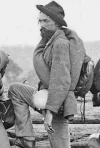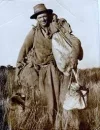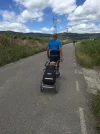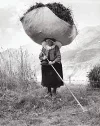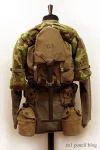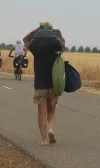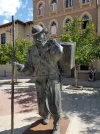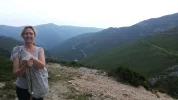While working as a volunteer this July-August at the Pilgrim Office at Santiago, I saw an amazing array of old-school methods for packing Camino gear. Included were these observations (each seen multiple times):
1. Pilgrims with two shoulder "haversacks," one over each shoulder in an "X" configuration. However, none of these folks were using two poles. If they had a pole, it was a single staff. The side-hanging haversacks would have likely impeded the swing of dual hiking sticks. Still, you can easily get up to 30 liters in these two bags - 15 or so liters in each.
2. Pilgrims with a long-rolled "bedroll." The ends of the "roll" were fastened with a tie or strap, like a huge piece of candy. This tie or strap was then attached to a second strap that permitted the entire roll to be carried on one or the other shoulder.
Interpolating from my US cowboy bedroll knowledge, the ideal way to construct this would likely be:
- Lay out waterproof layer, like your poncho (folded in half - lengthwise, or in a square);
- Lay out your sleeping bag or liner, folded to be smaller than the outer poncho
- Lay out your dry, clean clothing on top of the sleeping layer
- Lay out your "bumpy kit" toiletries, extra footwear, supplies, etc. on top of the clothing layer.
The closing step is two-stage. Pay attention! This is important.
1. Roll the sleeping bag or liner, with everything except your rain gear into a long, tight bundle (like the longest cigarette or cigar you have ever seen). Fasten both ends, and perhaps add another fastener in the middle. I advise something like velcro straps, so they are easily adjustable, or adjustable web straps with adjusting fasteners and clip closings. You can use a very strong rubber band in the middle. The critical thing is to get this as narrow as you can tightly roll it.
2. Place the tightly rolled sleeping, clothing kit, onto one end of the flat, folded waterproof layer. If the folded waterproof is squarish, a diagonal roll from corner to corner works best to keep it tightly bound.
The two-stage roll is key to your being able to retrieve your waterproof gear when the inevitable rain comes (this is the Camino) without having to unwrap everything. That is how the cowboys did it...

Tightly roll the internal roll using the waterproof roll. When done, fasten the ends (like a piece of taffy). Fasten the securing straps to an appropriate shoulder line or strap.
Toss this over your shoulder and you are ready to go.
All said, I think (IMHO) that the resulting 6-8 kilos riding on one shoulder, even if alternated as you walk, would be more tiring and painful than using a standard, modern rucksack. Modern rucksacks are scientifically researched, designed, and tested to distribute weight properly without causing undue stress or strain on your skeleton.
Plus, there are several items that you could not, or would choose not to include in your "bedroll." Examples include: spare sandals or flips flops, water bottles, electronics, first-aid supplies, snacks, guide book, sunglasses & spare glasses, medications, etc.
At the end of this exercise, I see someone toting a "bedroll" over a shoulder necessarily carrying a second haversack over the other shoulder. The resulting load bearing capability would likely be far less satisfactory than using a rucksack, at least IMHO.
While I have seen these "alternative" carrying methods and wondered at length about them, I am not tempted to use one. I have done four Caminos using my Osprey Kestrel 48 rucksack.
After much experimentation and trying alternatives, I keep coming back to this bag, year after year. Once this rucksack "dissolves," I may consider another rucksack. But, I know from experience that I need about 45 liters of volume, a very good shoulder harness, waist band, and back suspension system.
Even on a shorter Camino, where I take less with me, I just pack looser and cinch the rucksack tighter. It all works. More importantly, my back "likes" the fit and "feel" of this harness and back support system. It feels natural to have it on. At the end of the day, when I take the rucksack off, it feels "odd." I maintain that is the sign of a well-fitted rucksack.
I hope this helps.





